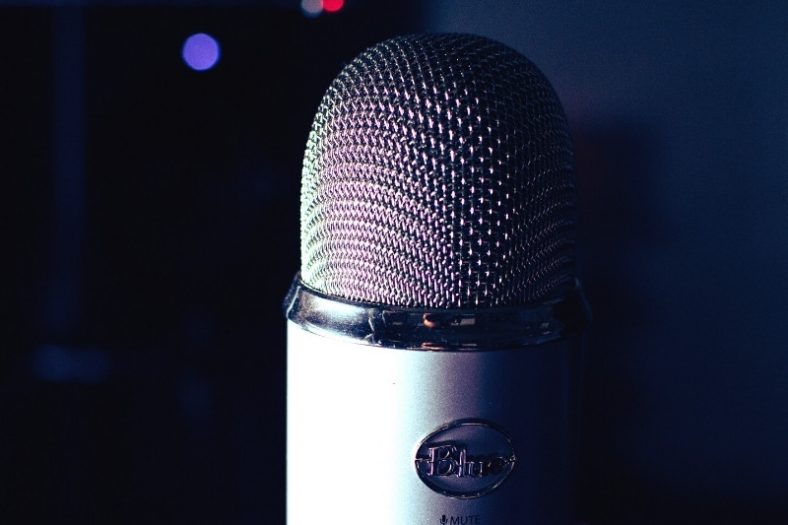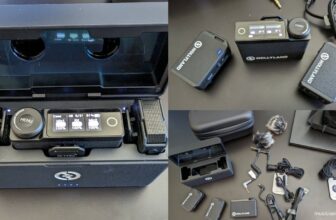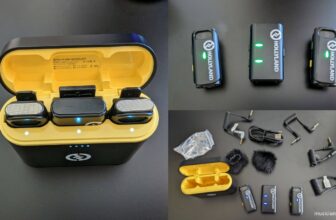Best Settings For Blue Yeti Microphone (Ultimate Guide)

The Blue Yeti is an affordable USB mic for professional recording. A podcaster’s favorite, it doesn’t require an external audio interface or dedicated drivers to work properly. All you have to do to get a good sound out of the Blue Yeti is to plug it into your computer and optimize its settings.
The Blue Yeti is great because it allows you to create professional recordings without additional equipment. It sounds good on the fly, but it can sound even better if you know what you’re doing. If you have a Blue Yeti and want to learn how to make the most of it, you’ve come to the right place.
Contents
What can you do with the Blue Yeti microphone?
The Blue Yeti microphone features some useful built-in options, which include a pickup pattern switch with four polar patterns, a headphone volume knob, a mic gain knob, and a mic mute switch. Tweaking these settings is essential for getting a good sound out of the Blue Yeti.
The pickup pattern switch
The pickup pattern switch allows you to choose between four different directionalities, i.e., four different ways the mic captures sounds in space. These are called polar patterns and are represented by symbols that describe, visually, how the mic reacts to the surrounding environment.
What are the four settings on the Blue Yeti microphone?
The four polar pattern settings available in the Blue Yeti microphone are cardioid, stereo, omnidirectional, and bidirectional. More than any other built-in setting in the Blue Yeti, the polar pattern you choose significantly affects the quality of your recordings.
Cardioid mode: when set to cardioid mode, the Blue Yeti will only pick up sounds produced directly in front of it. For this reason, the cardioid mode is ideal for recording podcasts. When using the cardioid mode, you can expect a full, rich vocal sound, with little to no ambient noise.
Stereo mode: when set to stereo mode, the Blue Yeti will pick up sounds coming from the left and right (as well as the middle) to capture a wide sound image. It’s the mode you will want to use for making ASMR videos or recording string musical instruments.
Omnidirectional mode: when set to omnidirectional mode, the Blue Yeti will pick up as many sounds as possible. It’s different from the stereo mode because it’s much more sensitive to ambient noise. When you record in omnidirectional mode, you record everything! For that reason, this mode is best used for things like capturing room ambiance and making sound for film.
Bidirectional mode: when set to bidirectional mode, the Blue Yeti picks up sounds coming from both the front and rear of the microphone. Think of it as having two simultaneous cardioid modes activated, one at each end of the mic. It’s best used for duets or for recording a conversation between two people – which can also be very useful for podcasting.
Volume and mic gain knobs
The two knobs, which should not be confused, are used to adjust your headphones’ volume and your microphone’s gain. Headphone volume concerns the playback volume of the mic and affects sound monitoring. Mic gain concerns the amount of drive applied to the mic and affects sound quality.
For an in-depth description, check out our article about the differences between volume and gain.
Mute switch
A simple button that mutes the microphone. It’s great for podcasters because it allows you to stop listening to your voice on headphones and focus on what you’re saying instead. It has other useful uses now and then, but it’s not relevant for optimizing how the Blue Yeti sounds.
How can you optimize your Blue Yeti microphone?
You can optimize the Blue Yeti microphone by choosing the right settings, paying attention to mic placement, considering the importance of room acoustics, and using audio processing software.
Considering the Blue Yeti is mostly used for voice recordings (and podcasts in particular), I’ll be focusing on how you can get the crispiest, cleanest possible vocal sound out of the Blue Yeti. However, mic optimization isn’t a one-off given: once you understand the way it works, you should be able to get the best possible Blue Yeti sound for any purpose, not only vocal/podcast recording.
The best setting for the Blue Yeti microphone
Now that you know what the built-in settings of the Blue Yeti microphone can do, you should be able to make the most of them. For vocal recording, the ideal polar pattern is the cardioid mode, which will prevent the mic from picking up unwanted environment noises and give you a vocal sound as “whole” and precise as possible.
Monitoring is also important. You need to listen to what you’re recording correctly to make correct decisions in the process. To achieve this, keep your headphone level at a low volume.
It’s tempting to crank the volume up because louder sounds can be incorrectly interpreted as better sounds (you can learn more about perceived loudness here). Most mixing engineers like to work at a low volume to make better mixing decisions; you should do the same while working on your vocal recordings.
Using proper mic gain settings is crucial for getting the best out of the Blue Yeti. There’s not a magic number for mic gain that will work every single time, so you’ll have to use common sense here. Are your recordings very quiet? Then you need more gain. Does your voice sound distorted and too hot? Then you need less gain.
Depending on the tone of your voice, you should play around with the Blue Yeti mic gain settings for a while to find that sweet spot. Keep in mind that mic placement goes hand-in-hand with gain because it also interferes with how loud the Blue Yeti captures sound.
Ideal mic placement for the Blue Yeti microphone
Mic placement concerns your position, relative to the microphone, during recording. Naturally, you should be close enough to the mic for it to capture your voice. But understandably, you shouldn’t be too close to the mic unless you want people to hear the saliva moving inside your mouth!
Speaking too close to the microphone can also give way to unwanted sound artifacts such as pops and clicks. These can be a problem even if you’re recording vocals at an ideal distance, so buying a pop filter or a boom mic cover is probably a good idea. These are very affordable and can make a huge difference in sound quality.
If you need to scream something like ‘parallel proximity’ during a podcast, and you don’t have a pop filter just yet, here’s a handy music-recording hack: put one finger in front of your mouth. It should deal (to a certain degree) with those nasty P sounds.
What’s the ideal distance for recording vocals with the Blue Yeti microphone?
Depending on your tone and how loud you speak or sing, try to stand 4 to 10 inches (10 to 25 centimeters) away from the mic. The Blue Yeti should be in a stable position, and your head should be directly in front of the microphone. If possible, use a pop filter to deal with sharp sibilants.
The best room acoustic for the Blue Yeti
Proper settings and a correct mic placement should be all you need to get a clean, crispy vocal sound out of the Blue Yeti. But as with all things sound-recording, you can always take quality one step further. Once you get the basics right, that’s when you should consider room acoustics.
In a way, acoustics is the defining sound recording element that makes the difference between nice recordings and world-class recordings. The upside to getting your recording room or studio acoustically treated is that it will make a huge difference in your audio work. The downside is that it can be very time-consuming and expensive.
Covering the entire topic of how acoustics can affect the quality of your Blue Yeti recordings would take more than just a few paragraphs, so please check this ultimate guide for acoustic treatment to learn more if you’re interested in upgrading the sound of your room/studio.
Optimizing the Blue Yeti microphone with audio processing software
Even though the Blue Yeti doesn’t require an audio interface or specific drivers, it does need to be recorded into something. Often, that “something” is a digital audio workstation (DAW).
Even if you’re just recording basic podcasts, you should rely on the processing power of a DAW to optimize the sound of your Blue Yeti. Don’t worry: there are plenty of free DAWs around. But what tools can be used to make Blue-Yeti recordings sound better, and how?
How can I make the Blue Yeti microphone sound better with audio effects?
Inside a DAW, you can process your Blue Yeti recordings with audio effects such as a compressor (to reduce dynamics and make the sound tighter), a de-esser (to eliminate sharp sibilants), an EQ (to get rid of unwanted frequencies), or a noise reduction effect (to neutralize unwanted background sounds and noise).
Compression: a compressor is a tool used to shape audio dynamics, and it’s a podcaster’s best friend. When you speak, some words and syllables are louder than others; this will happen even if you’re a great podcast host. In a nutshell, a compressor reduces the difference between the loudest and quietest syllables in a recording. This makes your voice sound much tighter and easier to understand.
To learn more about this, and other types of audio process, then check out our article on audio dynamics.
De-essing: a de-esser is also an audio-dynamics processing tool, but it’s used for a much different purpose. Think of it as the software version of a pop filter. It’s a very specific type of compressor that tracks sharp sibilants in a recording and gets rid of them. Learning the ins and outs of how de-essing works can be tricky, so try to stick to a nice preset.
EQ: EQ is great for shaping the tone of your recordings and even altering (to a certain degree) the way your voice sounds. It’s also ideal for dealing with the super-high and low frequencies that Blue Yeti captures.
Blue Yeti’s frequency response goes from 20 to 20,000 Hz, but you’ll seldom need to count on the full frequency spectrum for recording vocals. Applying a simple low-pass and high-pass filter can make wonders for sound quality.
Noise reduction: noise reduction tools can help you to get rid of background noise. There are some great premium noise-reduction VST plugins out there, as well as a few effective free options. You can learn how to remove noise with Audacity in just two minutes.
Additionally, you can use non-DAW software such as VB-Audio’s Voicemeeter to improve the sound quality of your Blue Yeti recordings, as seen in this video.
Summary
In sum, the best guidelines for setting the Blue Yeti microphone are: using the cardioid mode for avoiding unwanted background sounds and ambient noise; monitoring sound at a low headphone volume; making sure that the gain knob is loud enough to drive the sound without causing it to distort; sitting 4-10 inches (10-25 centimeters) away from the mic, facing it directly; considering the importance of proper room acoustics; experimenting with audio effects such as compressors and EQs.
By following these guidelines, you should be able to make the most of your Blue Yeti microphone, which already sounds pretty good for a USB mic to start with!





